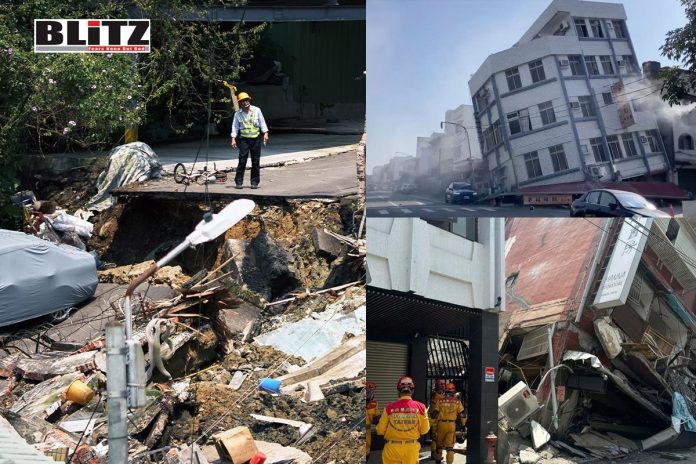Following Taiwan’s strongest earthquake in 25 years on Wednesday, rescuers urgently worked to liberate numerous individuals trapped in highway tunnels. The formidable 7.4 magnitude tremor struck the island’s east coast at 7:58 a.m. local time, its epicenter situated 18 kilometers south of Hualien city and at a depth of 34.8 kilometers, as per the US Geological Survey (USGS). Subsequent strong aftershocks reverberated across the island, notably felt in the capital Taipei.
Following the initial quake, the USGS reported 29 aftershocks surpassing a magnitude of 4.0 near the epicenter, including one exceeding 6.0 and 13 reaching or surpassing 5.0. Taiwan’s National Fire Agency updated the death toll to nine, with 934 individuals sustaining injuries, though the severity remains unspecified.
As emergency responders continue their efforts in Hualien County, 75 individuals have been successfully rescued from various tunnels, providing a glimmer of hope amidst the ongoing challenges. However, the situation remains dire as 137 people still await assistance. Among those stranded are 50 employees from Silk’s Place Hotel Taroko, their whereabouts uncertain as authorities struggle to establish contact. Nevertheless, there have been successes, with two German citizens rescued from a tunnel earlier, demonstrating the resilience and dedication of rescue teams in the face of adversity.
Hualien County bore the brunt of the fatalities, with the NFA confirming that all deaths occurred within its borders. Among the casualties were three hikers tragically killed by falling rocks in the renowned Taroko Gorge. Additionally, a truck driver lost his life due to falling rocks near a tunnel along the Suhua Highway on the east coast. Extensive damage has been reported, including collapsed buildings, power outages affecting thousands of homes, and the closure of a major highway due to landslides and rockfalls, as stated by Taiwanese officials.
The majority of those trapped are concentrated in two road tunnels located in northern Hualien County, according to the NFA. Additionally, two German nationals find themselves stranded in a third tunnel within the county. Among the tunnels, the 400-meter Jinwen Tunnel holds 60 individuals captive, situated along the Suhua Highway, renowned for its scenic beauty yet notorious for its narrow and perilous path spanning 118 kilometers (73 miles) along the east coast. Simultaneously, rescuers are mobilizing to aid 12 people, including two Canadians, stranded on a trail within Taroko Gorge.
Taiwan’s Central Weather Administration spokesperson issued a warning, forecasting powerful aftershocks potentially reaching magnitude 7 until the week’s end. Describing the harrowing experience, Taipei residents recounted moments of terror and chaos caused by the quake. Chang Yu-lin described feeling the strong tremors, prompting immediate safety measures, while Chen Nien-tzu characterized the event as “really wild,” encapsulating the intensity and unpredictability of the disaster.
Following the quake, initial tsunami alerts were issued across Taiwan, southern Japan, and the Philippines, leading to flight suspensions by airlines as a precaution. Fortunately, all tsunami warnings were eventually lifted, but not before military personnel in Taiwan were mobilized to aid in disaster relief efforts. In response to the crisis, schools and workplaces ceased operations amidst ongoing aftershocks, as confirmed by the Defense Ministry. Outgoing President Tsai Ing-wen promptly directed her administration to swiftly assess local impacts and provide necessary assistance, emphasizing collaboration with local authorities to mitigate the disaster’s repercussions.
Taiwan, an autonomous island situated to the east of mainland China, accommodates approximately 23 million inhabitants, with the majority residing in the urbanized cities along its western coast, including the capital city. Positioned within the Pacific Ring of Fire, Taiwan experiences frequent seismic activity and volcanic eruptions due to its geographic location along the Pacific Ocean’s perimeter.
Wednesday’s earthquake, the most potent since 1999 according to the Central Weather Administration, revived memories of the devastating 7.7 magnitude quake that struck south of Taipei that year, claiming 2,400 lives and leaving 10,000 injured. Notably, Hualien County, characterized by its rugged and remote terrain, harbors around 300,000 residents along the sparsely populated eastern coast. In 2018, the region was rattled by a magnitude 6.2 earthquake, resulting in the loss of at least 17 lives and injuring over 300 individuals.
The aftermath of the earthquake in Taiwan continues to unfold as authorities grapple with assessing the full extent of the damage. Road and rail closures have impeded access to the quake’s epicenter in Hualien County, where more than 100 buildings have been reported damaged, according to the National Fire Agency, with roughly half of them located in the same county. Search and rescue efforts persist, notably at the nine-story Uranus Building, partially collapsed and trapping residents. Although 22 individuals have been rescued thus far, operations remain ongoing.
The impact extends beyond structural damage, with over 91,000 households left without electricity, prompting swift action from the government-operated Taipower Company to restore power. Social media footage depicts the chaos and destruction, showcasing collapsed buildings and residents aiding trapped individuals. Videos captured during the quake reveal scenes of vehicular tumult, swaying infrastructure, and commuters struggling to maintain balance. Additionally, media broadcasts showcase firsthand accounts of the tremors’ impact, illustrating the widespread disruption experienced across the island, from trembling power lines to shaking chandeliers in local establishments.




